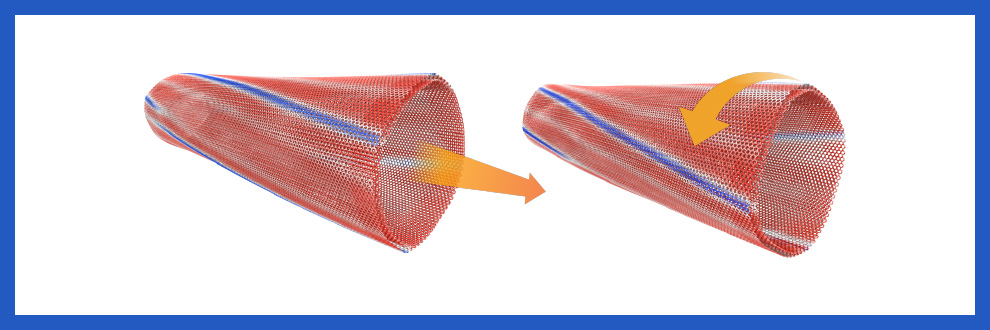
The smallest Archimedean pump
Nanotubes constitute an important class of nanoscale materials exhibiting unique physical properties with great technological potential. While often referred to as miniature cylinders, its cross section may exhibit a polygonal shape with extended facets separated by sharp vertices. This is most commonly observed for inorganic boron nitride nanotubes but has also been demonstrated in their carbon counterparts.
CC&B researcher Roberto Guerra, in collaboration with scientists at SISSA and Tel Aviv University, discovered a new material phenomenon, where minute mechanical manipulations induce unexpected pronounced super-structure reconfiguration in faceted nanotubes. Specifically, coaxial inter-wall sliding in the rotational or longitudinal directions of achiral double-walled nanotubes results in global facet rotations or a successive sequence of complete faceting and unfaceting events, respectively. For bichiral double-walled nanotubes inter-wall telescoping results in a screw-like rotational motion of the helical facets with a surface velocity that is 20-fold larger than the pulling rate for the tube diameters considered. The latter is a realization of the smallest Archimedean pump that may be utilized to for the directional transport of physisorbed matter. The unique facet dynamics discovered in this study involves much larger atomic displacements than those induced by standard Moiré patterns in planar incommensurate interfaces or non-faceted nanotubes. Therefore, they open new global energy dissipation channels that substantially increase dynamic friction, explaining recent experimental observations.
Since facet dynamics is found to be strongly dependent on the chirality of the different nanotube walls, it is expected that the inter-wall pulling force trace will encode information about the identity of the various tube shells. This may become valuable in terms of detailed material characterization of these systems, allowing access to the specific sequence of chiralities of successive tube walls. Importantly, the new material phenomenon discovered in this study is of general nature and should also appear in other members of the wide family of layered materials. Furthermore, apart from its intriguing basic science aspects it also holds great technological promise for the control and manipulation of the physical properties of low-dimensional layered materials.
Guerra, R., Leven, I., Vanossi, A., Hod, O., & Tosatti, E. (2017).
The Smallest Archimedean Screw: Facet Dynamics and Friction in Multi-Walled Nanotubes.
Nano Letters.
http://pubs.acs.org/doi/pdf/10.1021/acs.nanolett.7b01718
